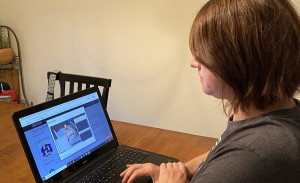How do you teach a nursing student to know what lungs should sound like, when a heart is beating irregularly or if that lump in the abdomen is normal when you can’t be together in person?
At SDSU, the answer was found in Shadow Health, a Florida-based leader in educational simulation technology. The firm and its programs weren’t unfamiliar to the College of Nursing. Alyssa Zweifel, the college’s healthcare simulation center assistant director, said SDSU was going to implement some of Shadow Health’s modules into the college’s curriculum in the fall. Faculty were to be trained in May.
When it was announced that students wouldn’t return to school March 16, all signs pointed to online education when classes resumed.
That included all clinical lessons, whether for first-semester nursing students or fifth-and-final semester nursing students.
Matching up the Shadow Health modules with the college’s curriculum was a weeklong challenge, Zweifel said. Working with Cassy Hultman, clinical site manager, Zweifel created a giant spreadsheet to identify where each of the 550 students on four different campuses was at in their clinical hours.
First-semester students hadn’t started clinicals yet while fourth- and fifth-semester students had a good start on their spring semester clinicals, Zweifel said.
That aligning took a week plus faculty training sessions were needed on using the virtual simulation program. It helped that some faculty had used Shadow Health during the pursuit of their master’s degree. The company offered Zoom training sessions and provided a self-training module for students to prep with before beginning graded activities.
Shadow Health grades students as they progress through the modules, which generally take 60 to 90 minutes to complete, Zweifel said.






